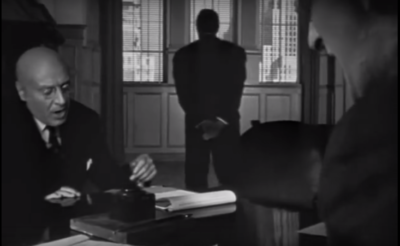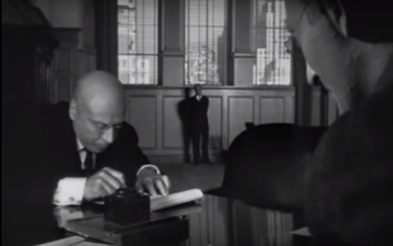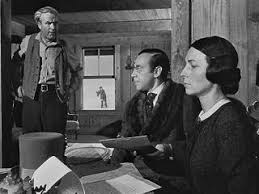https://drive.google.com/open?id=1osVTlRjreExRVZS_2TIIw4dfjmtJqJ_N
Monthly Archives: November 2018
Filters
Citizen Kane Essay – Is It The Best Film
Citizen Kane Essay – Best Scene
Citizen Kane Essay – Production Context
The Production of Citizen Kane
Citizen Kane (dir. Orson Welles, 1941) is widely considered the greatest film ever made. The production context behind this film greatly influenced the end look and feel of this film.
Welles came into the fame after his radio broadcast of War of the Worlds in 1938. This led to the Hollywood studio RKO hiring him to make a film, which they ultimately gave him complete creative control over. This was practically unheard of in Hollywood, and meant that the film was exactly what Welles wanted it to be, as long as it stayed under the budget of $500,000. Welles’ history working in the theater influenced the film to look like a stage production in some ways. In addition, the cast were part of Welles’ theater group, so they were trained to act on stage, rather than on-screen.
There were a number of new inventions that made Citizen Kane an incredible film. The cinematographer, Gregg Toland, made use of a new deep focus lens, which allowed everything in the scene to be in focus all at once. This very effective in some scenes, because it creates optical illusions that change the way audience see some things. For example, in the shot below, Kane seems to be the same size as the window, but as he walks towards it, he is dwarfed by its size. This is reflects how Kane is becoming smaller as he loses his power and influence. Inventions like this one, and the use of them throughout Citizen Kane, make the film very innovative.


Citizen Kane is famously based on the life of William Randolph Hearst, an American businessman, politician and newspaper publisher. While Welles denied these accusations, Hearst used his immense power and influence to limit the amount of theaters where Citizen Kane could be shown. This led to the film failing at the box office, and Welles’ career being seriously harmed. However, the character of Kane – a prominent newspaper owner who tries to start a career in politics – reflects Hearst’s life in many ways. As Hearst was an easily recognisable figure for the audience, Welles’ portrayal of him led to the boycotting of the film. It wasn’t until 1956 when Citizen Kane was revived, that the film received the recognition that it deserved.
Why I think that Citizen Kane is the greatest film of all time – task 3
Firstly , I think Citizen Kane (1941 , directed by orson Welles) is one of the greatest films of all time because the story is about an ordinary man , Charles Foster Kane , who has lived an extraordinary life and it is a story of his life and and it is quit candid and realistic and it is the realism of this film that drew me to it because , despite the fact that Kane was wealthier than I could ever imagine , ! could actually feel empathy for his man and his wealth and behaviour did not isolate me from him and that allows me to begin to understand him because Kane’s desire for love and admiration is a very human desire that we all have and Kane’s desires touch so many people because we all have them and it creates a universal experience between the audience and the characters.
Secondly , the film was a scathing indictment of the newspaper magnates who controlled the American media in 1941 and, although the film was scathing , the film is subtle in it’s critiques and it is not a heavy – handed morality tale , it just points out the faults in America’s media at the time by examining the life of Charles Foster Kane and the film depicted how powerful the newspaper magnates really were , and from the point of view of a modern audience , the power that they held was shocking , especially when you remember the fact that Citizen Kane was released less than a century ago and the audience can look at the current media landscape and realise that , although a lot of things have changed for the better , there is still a long way to go in terms of a few people having control over the media but things are steadily improving.
Thirdly , the film effectively shows how wealth can isolate people and this aspect of the story makes the film seem more like a cautionary tale against the allure of wealth , although , money itself is not the problem in this film , the problem is with how people with money acts and how easy it is for money to turn someone into a terrible person , in the film we see Kane make this transition from a respectable newspaper owner , to someone who is concerned with power and little else and parallels can be drawn to real – life figures and this is true in both 1941 and 2018 and this helps to make the film , a timeless classic.
To conclude , I think that Citizen Kane is one of the best films of all time because it helps us to empathise with a person who we wouldn’t usually invest our time and energy into getting to know and as we learn about his life , we begin to see him less as a repulsive human being and more as a flawed person who only wants love and he unfortunately never gets the love that he was seeking.
Citizen Kane: Context on Production

Citizen Kane was a film released in 1941 produced by Mercury Productions and distributed by RKO radio pictures with a supposed budget of $500,000 but was likely more as it is now believed to range between $600,000-$900,000 due to set costs and budget setbacks. This wouldn’t of been a problem for RKO if WW2 wasn’t going on at the time and their were economic cuts what hurt funding films. However this small budget likely only affected how fast the film was to complete and the colour of the film. The fact it was black and white helped the movie with its realism but plays into the fact Orson Welles wanted to create his own style and that’s why its believed this film created or brought to the forefront the noir genre. The contract Welles received from RKO president George Schaefer was very incredible deal for the time as he was given creative freedom from while also allowed him to produce, direct and perform of two of his own films. Hollywood Studios did not like the contract with it being consistently mocked in the trade press.
During production Wells only wanted to use Mecury actors as they were new to film and became upset when Gino Carrado was cast in it. However the film were feature film debuts of William Alland, Ray Collins, Joseph Cotten, Agnes Moorehead, Erskine Sanford, Everett Sloane, Paul Stewart, and Welles himself, this launched several of their acting careers. Welles used the cinematographer Gregg Toland who he saw as the best in the world. Toland also wanted to work with Welles as he liked the idea of working with a new director with the unusual role of creative freedom, he saw it as a chance of creating new styles in film.
On June 29th 1940 Citizen Kane started filming and finished on October 24th. Locations used for filming took majority on Stage 19 Paramount Studios and the locations of Balboa Park and San Diego Zoo.
Throughout the films production and first year of release was controversy such as the authorship of the script as Herman. J Mankiewicz wanted credit. This was resolved though as Welles shared credit for the screenplay. Basing Charles Kane on William Hearst brought the most controversy as it enraged him into banning any mention of the movie in his papers and threatened cinema’s to not show it. This is likely the main reason the film failed at the box office. There were other controversies during the production such as Welles being sued by a critic however they are not as notable as the above.
Favourite scene from citizen Kane
My favourite scene from Citizen Kane (Orson Welles, 1941) is the scene situated in Mrs Kane’s Boarding School. To me it is one of the most masterful pieces of work in the film. The use of sound and lighting to show dominance, paired with the beautiful flowing camera work really helps set the scene and create a sense of verisimilitude.
My first point will look at the snowy scene wherein we can see a young Charles Foster Kane playing by himself. Here the Mise En Scene conveys simplicity of life and happiness. The lighting is very bright which hints to how fond Kane was of his childhood, it shows positivity and contrasts with how his life is later on. The actual scene is extremely simple and this correlates to his simplistic and innocent life. As a child he had nothing to worry about. However when the camera tracks into the house the scene is much more complicated and full of objects. This shows how the current conversation is going to complicate Kane’s life.

Additionally, the camera work is extremely fluid and helps to push the conversation without interrupting it. This is especially good because the dialogue is fast and any interruptions may cause the viewer to lose track of the conversation and miss certain parts out. This is seen most notably in the instance where the camera tracks through a split in half table which then merges together to be seen in shot. This creates a sense of fluidity and in my opinion is an outstanding shot and shows Welles’ creativity

Not only that, but lighting plays a big part in the dialogue scene. Throughout the whole scene much of the light is focused on Mrs Kane – showing her dominance over her husband and her control over the future of her child. The lighting foregrounds Mrs Kane and shows how important her opinion is in this scene and this conversation. It is very hard to pick out unless you know what to look for but it has such a big impact and therefore is one of the reasons this is my favourite scene.
Finally i am going to look at the how the size of the adults shows dominance over young Kane as this for me really stood out. The physical size correlates to power and seeing them tower over Kane reveals that his future is in their hands, the tallest of them all being Mr Thatcher (George Coulouris). This foregrounds Thatcher and implies that he is now the person with most power and influence over Kane. Kane’s future is in his hands. For me this scene beautifully reveals Kane’s past, and the beginning of his journey to become this new man who is vastly different to his child self.

Explain how the production context of Citizen Kane influenced the “look and feel” of the end product
The considerable success of the movie can be attributed to the context of production of the movie. Welles had been given a budget of $500,000, something unbeknown and out of the ordinary for a generally unknown director, however his works within the theatrical aspect of show business was noticed by Hollywood due to his success within orchestrated plays and radio specials from the Mercury Theatre. It was in 1938 that Welles conducted the broadcast that would put him in the spotlight for Hollywood studios, when he broadcast the “War of the Worlds” in which he imitated that a galactic outbreak of aliens had ensued. The play was orchestrated in the form of a newscast, which sparked cultural controversy and skyrocketed Welles as one of the most spoken of actors that were in the West.
Soon after, Welles would be approached by RKO Studios, who were mainly known for their comedy and monster movies. In an effort to improve their reputation as a significant studio that could compete artistically, RKO studios offered a contract to Welles that was surreal in regards to the time, which gave him drastic artistic control, an offer Welles happily accepted, allowing him to star in the movie, direct the movie, and additionally employ actors from the Mercury Theatre he had become notorious from.
Another factor that affected the finality of the film can be identified with the films parallelism to the life of a William Randolph Hearst. The plot of the movie was widely believed to be a fictional rendition of him, due to Hearst being renowned for newspaper publishing, aspiring in politics and being an enthusiastic art collector. Hearst’s influence throughout show business and specifically the media, allowing for him to shun various sources of mass information and even offered the studio money to destroy the film completely. Therefore, this effected Citizen Kane’s box office, which vastly contradicts its title of the greatest movie ever made, and drastically morphed the opinion of the public towards the movie at the time, only being appreciated for its cinematic excellence years later.
Citizen Kane: Is it the best film of all time?
In my personal opinion Citizen Kane isn’t the best movie of all time however I do understand why critics cite it as the best movie of all time. There are three major reasons why it is considered top and that is because of its critics pride of being American, it being top on a American list and how its lasted over time.
The critics pride of being American or any American viewer can be seen in this film, even its popularity wasn’t seen until the next decade, it was released during a time in war. So when Welles released it this showed the themes of the American dream and the true American. This likely resonated well with critics at the time because of that they looked passed Kane’s floors as a person and chose to look at his better qualities. This is relevant as you can see this in other films considered in the top 100, the most famous one being Rocky what is another one what brings in the idea of being a proud American even though he starts off as being this weak intellectual, who smokes and works for loan shark. However they look past that and he is seen as someone who embodies the American way like Kane, so during WW2 it was a good reminder who the identity of being American what likely hit critics on a personal level as well.
It’s on an “American” top 100 list of best of all time what can show that all the top movies on the list are not considered the same by other countries best films. If you were to compare the top 50 movies of the AFI with BFI(2nd of the top 50 list and 3rd on directors list) top 50 there is more of mix of films from different cultures, even though that list has its issues like the top 100, it at least doesn’t limit itself. Unlike the BFI the AFI only celebrates american film culture and doesn’t celebrate any other culture what limits the list and doesn’t appreciate film as a whole. This is why Citizen Kane doesn’t have a claim to being the best film ever made as it has never ranked correctly on unbiased list. This list shows to bias and more critic opinion than general opinion as Star Wars is chosen over Empire Strikes Back even though it is generally the more well received movie and considered best western of all time The Good, The Band, And The Ugly doesn’t make the list even though it was produced by United Artists an American Company what makes it fit the criteria to make the list. If the list was more general opinion with critics only giving the names of films they thought should be considered at the top I do believe we would see what is considered the best film of all time, however I doubt that as it always comes down to personal opinion.
It has survived well over time compared to other older films, yet it was seen as the best until a decade after its original release by European countries. I do believe this is though why it is resonates well with critics though as for a movie from 1941 it holds up very well, with it not feeling as if its outdated. The movie may be black and white but instead of hurting the film it rather helps it by give its genre of being a noir film and that’s why its seen as a great film as for its time it was unlike anything else from before. This is why I feel is that it is still talked as one of the greatest as it feels like anyone can view its not down to personal taste and it lasts over time for it using everything what could hurt it to its advantage.
I do see the reasons for why its up there as the best but these lists in my opinion are not a good view of film industry as film is down to personal opinion. In the end I see the top 100 films more based off breakthroughs in the american film industry in general and these movies are the greatest examples of this.
